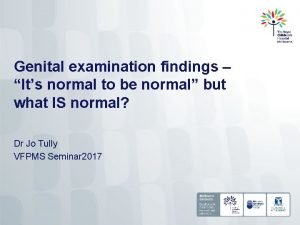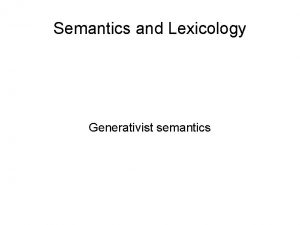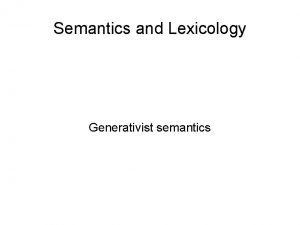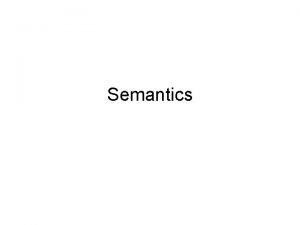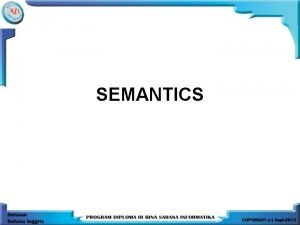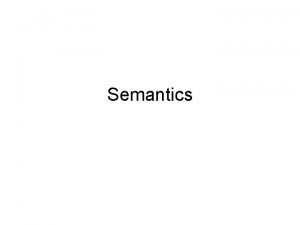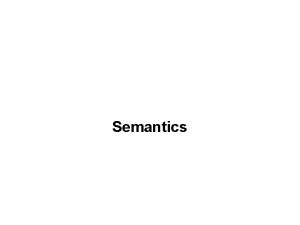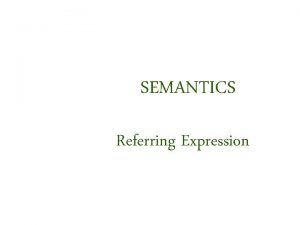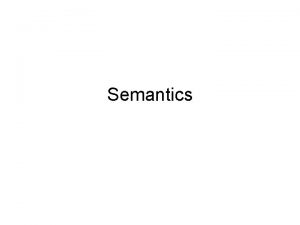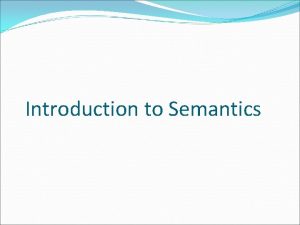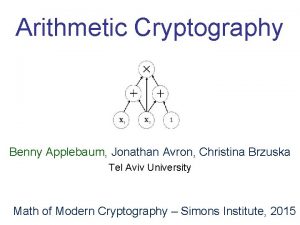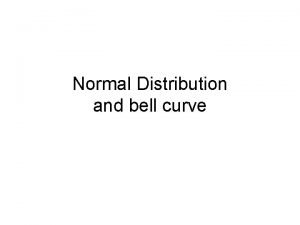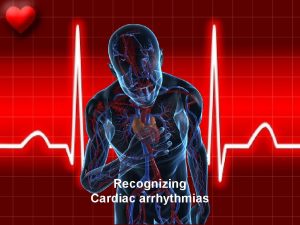KripkeStyle Semantics for Normal Systems Arnon Avron and



















- Slides: 19

Kripke-Style Semantics for Normal Systems Arnon Avron and Ori Lahav Tel Aviv University LATD 2010

Normal Gentzen Systems �Fully-structural propositional sequential systems �Normal derivation rule: ◦ The rule: s 1 s 2 … sm / c ◦ Its application: (s 1)+context 1 … (sm)+contextm (c)+context 3

Normal Rules �Example p 1 p 2 / p 1 p 2 , φ , ψ , φ ψ φ ψ 4

Normal Rules �Example p 1 p 2 / p 1 p 2 wff , φ , ψ , φ ψ φ ψ �Each premise is associated with a context restriction. 5

Many-Sided Sequents � Classical sequent: ( , are finite sets of formulas) � n-sided sequent: 1 ; 2 ; … ; n � Notation ◦ Let I be a finite set of signs. ◦ A signed formula: i ψ (i I and ψ is a formula). ◦ A sequent is a finite set of signed formulas. � Negative interpretation [Baaz, Fermüller, Zach `93] {i 1 ψ1, …, in ψn} is true iff ik is not the truth-value assigned to ψk for some i k n � Classical sequent notation is I = {t, f} { t ψ | ψ } { f ψ | ψ } 6

Normal Rules �A normal rule: ◦ Premises: sequents s 1 … sm ◦ Context restrictions: corresponding sets of signed formulas 1 … m ◦ A Conclusion: a sequent c �Its application: (s 1) (s’ 1) … (sm) (s’ m) (c) s’ 7

Examples �S 4’s Box , ψ I = {t, f} p 1 , / p 1 ={t φ|φ wff } {f φ|φ wff } � 3 -Valued , ψ Lukasiewicz's Implication [Zach `93] I = {f, I, t} f p 1 , , I p 1, I p 2 , , t p 2 , / t p 1 p 2 ={ i φ | i I , φ wff } (i. e. no context restriction) , φ; ; Σ ; , φ, ψ; Σ ; ; Σ, ψ ; ; Σ, φ ψ 8

Normal Gentzen Systems �Axioms �Weakenings �Cut i φ , j φ s s , i φ s , i 1 φ … s , in φ s �Finite for every i j in I for every i I where I ={i 1, …, in} set of normal Gentzen rules 9

Examples of Normal Gentzen Systems �Normal Gentzen systems are suitable for: ◦ ◦ ◦ ◦ Classical logic Intuitionistic logic Dual-intuitionistic logic Bi-intuitionistic logic S 4 and S 5 n-valued Lukasiewicz logic … 10

Kripke Semantics �Kripke Frame ◦ Set of worlds W ◦ Legal set of relations R 1, R 2, … W W ◦ Legal valuation v : W x wff I sequent s is true in a W iff i φ s. v(a, φ) i �A sequent is R-true in a W iff it is true in every b W s. t. a. Rb �A 11

G-Legal Kripke Frames �A normal system G induces a set of G-legal Kripke frames: ◦ A preorder R for every context-restriction in G. �If is the set of all signed formulas, R is the identity relation ◦ Generalized persistence condition If i φ , v(a, φ)=i implies v(b, φ)=i for every b s. t. a. R b. ◦ The valuation should respect the logical rules of G Respect a rule s 1, 1 , …, sm, m / c : If 1 i m. σ(si) is R i-true in a W, then σ(c) is true in a 12

Example: Primal Intuitionistic Implication (Gurevich ‘ 09) �Rules 1 2 p 2 , wff / p 1 p 2 p 1, wff , p 2 , wff / p 1 p 2 �Semantics , , , = Rwff Persistence if v(a, )=t then v(b, )=t for every b a Respect rule #1 v(a, )=t if v(b, )=t for every b a Respect rule #2 v(a, )=f if v(a, )=t and v(a, )=f ◦ v(a, ) is free when v(a, )=f and (v(b, )=f or v(b, )=t for every b a) 13

Strong Soundness and Completeness �For every normal system G, C├G s iff every G-legal frame which is a model of C is also a model of s. �Applications: ◦ Several known completeness theorems are immediately obtained as special cases. ◦ Compactness theorem. ◦ Basis for semantic proofs of analycity. ◦ Semantic decision procedure for analytic systems. 14

Analycity �A normal system is (strongly) analytic iff it has the subformula property, i. e. C├G s implies that there exists a proof of s from C in G that contains only subformulas of C and s. �Analycity implies: decidability, consistency and conservativity. 15

Semantic Characterization of Analycity � Def Given a set E of formulas, an E-Semiframe is a Kripke frame, except for: v : W E I instead of v : W wff I. � Notation Given a set E of formulas, C├Es. G iff there exists a proof of s from C in G containing only formulas from E. � Thm C├Es. G iff every G-legal E-semiframe which is a model of C is also a model of s. � Cor G is analytic iff for every C and s, if every G-legal frame which is a model of C is also a model of s, then this is also true with respect to sub[C, s]-semiframes. 16

Semantic Proofs of Analycity To prove that G is analytic, it suffices to prove: � Every G-legal semiframe can be G-legal frame. extended to a This can be easily done in many important cases: � ◦ ◦ Normal systems for classical logic, intuitionistic logic, dual and bi-intuitionistic logics, S 4, S 5, nvalued Lukasiewicz's logic… The family of coherent canonical systems. 17

Normal Hypersequent Systems This approach can be extended to hypersequent systems (with internal contraction). � Generalized communication rule: � G | s 1 (s 2 ) G | s 2 (s 1 ) G | s 1 | s 2 R is linear �Examples: S 4. 3 Gödel logic 18

Application: Adding Non-Deterministic Connectives to Gödel Logic � ◦ ◦ � General Motivations: Uncertainty or ambiguity on the level of the connectives Gurevich’s Motivation: proof-search complexity Examples ◦ v( ) [v( ) , v( )] G | , G | , ◦ v( ) [min{v( ), v( )} , max{v( ), v( )}] G | , � G | , G | , Remains decidable 19

Thank you! 20
 Arnon goldfinger
Arnon goldfinger Lms npru
Lms npru Compare procedural semantics and declarative semantics.
Compare procedural semantics and declarative semantics. It's normal to be normal
It's normal to be normal Fspos vägledning för kontinuitetshantering
Fspos vägledning för kontinuitetshantering Novell typiska drag
Novell typiska drag Tack för att ni lyssnade bild
Tack för att ni lyssnade bild Ekologiskt fotavtryck
Ekologiskt fotavtryck Varför kallas perioden 1918-1939 för mellankrigstiden
Varför kallas perioden 1918-1939 för mellankrigstiden En lathund för arbete med kontinuitetshantering
En lathund för arbete med kontinuitetshantering Särskild löneskatt för pensionskostnader
Särskild löneskatt för pensionskostnader Personlig tidbok fylla i
Personlig tidbok fylla i A gastrica
A gastrica Förklara densitet för barn
Förklara densitet för barn Datorkunskap för nybörjare
Datorkunskap för nybörjare Boverket ka
Boverket ka Mall debattartikel
Mall debattartikel Autokratiskt ledarskap
Autokratiskt ledarskap Nyckelkompetenser för livslångt lärande
Nyckelkompetenser för livslångt lärande Påbyggnader för flakfordon
Påbyggnader för flakfordon



